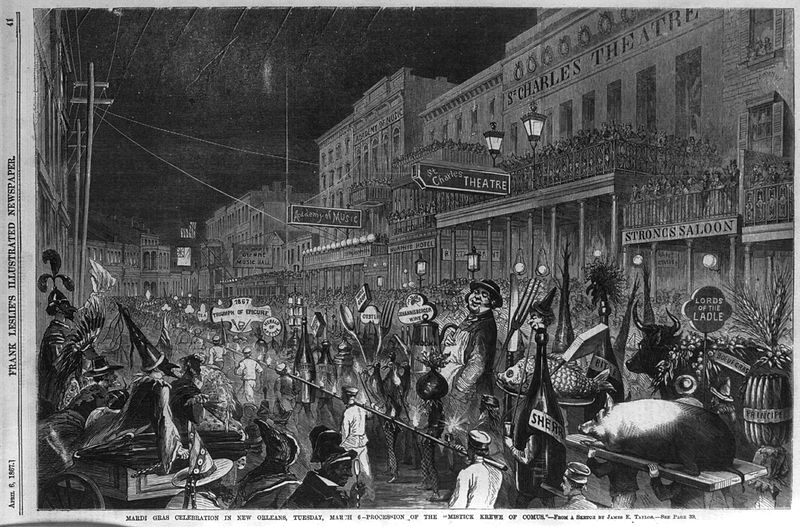 Home Page
Home Page
Samuel Clemens.
“The Mardi Gras Letter.”
In 1859, the Mystick Krewe of Comus paraded for the 3rd time.
By a happy coincidence, a 23-year-old Samuel Clemens, who was
apprenticing as a riverboat pilot, happened to disembark from
the Aleck Scott, which
had left St. Louis on 1 March and arrived in New Orleans on
Mardi Gras, 8 March, 1859 (The
Mark Twain Project). We see in the letter both the
excitement of a young man away from home experiencing Mardi Gras
for the first time, coupled with the observational skills and
the wry voice that would later make Mark Twain the great
American writer. Mardi Gras arose as an expression of New Oreans
culture, and was directed inward. Samuel Clemens may have been
the first to see its potential as a tourist attraction: "[It’s
the be]ginning of Lent, and all good Catholics eat and drink
freely of what they please, and, in fact, do what they
please, in order that they may be the better able to keep sober
and quiet during the coming fast. It has been said that a
Scotchman has not seen the world until he has seen Edinburgh;
and I think that I may say that an American has not seen the
United States until he has seen Mardi-Gras
in New Orleans."
Required
Optional

"Mystick Krewe of Comus. 1867."
Notes.
"The reputation of the Krewe was now so well established, that
long before the arrival of the day — March 8th — the greatest
interest was felt as to the coming exhibition. The subject chosen
was "Twelfth Night, or the courtly pageant of Misrule" and the
elegant manner in which the parade was conceived, and the
magnificence of its execution, is yet remembered and often spoken
of by those who witnessed it. They first appeared on Orleans
street, and proceeded to pay their respects to the mayor; welcomed
on every hand by immense crowds who had gathered to see them. Four
tableaux were given at the Varieties theatre, which was crowded to
overflowing, and the ceremonies wound up with a grand ball, the
Krewe disappearing as usual as the hour of twelve was tolled."
(Madden. Handbook
of the Carnival.)
"Carnival’s roots go back to the Middle Ages. The first
“official” Mardi Gras celebration took place in 1833. Bernard
Mandeville de Marigny, a wealthy landowner (and namesake of the
Faubourg Marigny neighborhood) sponsored a “creole-style”
celebration supervised by city officials. Even though the
celebrations were now “official,” they were still quite
disorganized and rowdy. In 20 years, the appeals to abolish public
Mardi Gras celebrations were renewed.
"In 1856, six Anglo-American transplants from Mobile formed a
secret society they named the Mistick Krewe of Comus. The krewe
held a 2-float night parade on Mardi Gras Day of 1857, and the
modern parade era was born. Comus shifted the focus of Mardi Gras
celebrations from citizens carousing in the street to citizens
passively watching a parade in the street. The change was such a
success that tourists began visiting New Orleans in 1858.
"Comus paraded from 1857 to 1861, but suspended their celebration
in 1862, because of the Civil War. By 1872, another group of
businessmen decided to hold a daytime parade on Mardi Gras day.
They named their organization The School of Design, and the king
of their parade was designated Rex, King of Carnival. Rex paraded
regularly from 1872 until 1917, but Comus took a hiatus from
parading from 1885 to 1890." (NOLA
History)
 Home Page
Home Page
